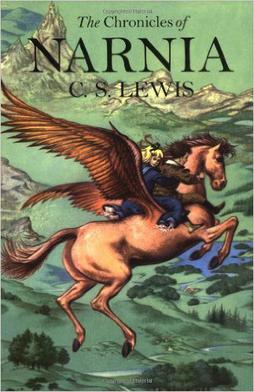
The Chronicles of Narnia is a series of seven high fantasy novels by British author C. S. Lewis. Illustrated by Pauline Baynes and originally published between 1950 and 1956, The Chronicles of Narnia has been adapted for radio, television, the stage, film and video games. The series is set in the fictional realm of Narnia, a fantasy world of magic, mythical beasts and talking animals. It narrates the adventures of various children who play central roles in the unfolding history of the Narnian world. Except in The Horse and His Boy, the protagonists are all children from the real world who are magically transported to Narnia, where they are sometimes called upon by the lion Aslan to protect Narnia from evil. The books span the entire history of Narnia, from its creation in The Magician's Nephew to its eventual destruction in The Last Battle.

Prince Caspian is a high fantasy novel for children by C. S. Lewis, published by Geoffrey Bles in 1951. It was the second published of seven novels in The Chronicles of Narnia (1950–1956), and Lewis had finished writing it in 1949, before the first book was out. It is volume four in recent editions of the series, sequenced according to the internal chronology of the books. Like the others, it was illustrated by Pauline Baynes and her work has been retained in many later editions.

The Voyage of the Dawn Treader is a high fantasy novel for children by C. S. Lewis, published by Geoffrey Bles in 1952. It was the third published of seven novels in The Chronicles of Narnia (1950–1956). Macmillan US published an American edition within the calendar year. with substantial revisions that were retained in the United States until 1994. It is volume five in recent editions, which are sequenced according to the novels' internal chronology. Like the other Chronicles of Narnia, The Voyage of the Dawn Treader was illustrated by Pauline Baynes, and her work has been retained in many later editions.

The Silver Chair is a children's fantasy novel by C. S. Lewis, published by Geoffrey Bles in 1953. It was the fourth published of seven novels in The Chronicles of Narnia (1950–1956); it is volume six in recent editions, which are sequenced according to Narnian history. Like the others, it was illustrated by Pauline Baynes and her work has been retained in many later editions.
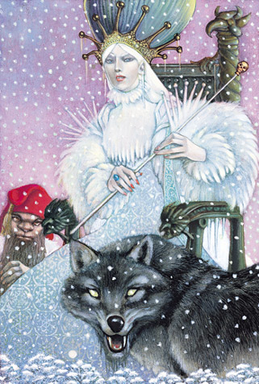
Jadis is the main antagonist of The Lion, the Witch and the Wardrobe (1950) and The Magician's Nephew (1955) in C. S. Lewis's series, The Chronicles of Narnia. She is commonly referred to as the White Witch in The Lion, the Witch and the Wardrobe, as she is the Witch who froze Narnia in the Hundred Years Winter.
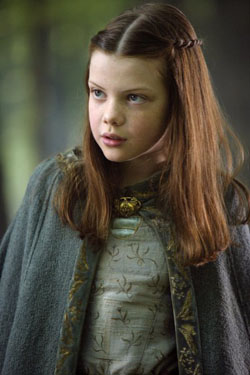
Lucy Pevensie is a fictional character in C. S. Lewis's The Chronicles of Narnia series. She is the youngest of the four Pevensie children, and the first to find the Wardrobe entrance to Narnia in The Lion, the Witch and the Wardrobe. Of all the Pevensie children, Lucy is the closest to Aslan. Also, of all the humans who have visited Narnia, Lucy is perhaps the one that believes in Narnia the most. She is ultimately crowned Queen Lucy the Valiant, co-ruler of Narnia along with her two brothers and her sister. Lucy is the central character of the four siblings in the novels. Lucy is a principal character in three of the seven books, and a minor character in two others.

Peter Pevensie is a fictional character in C. S. Lewis's The Chronicles of Narnia book series. Peter appears in three of the seven books; as a child and a principal character in The Lion, the Witch and the Wardrobe and Prince Caspian, and as an adult in The Last Battle. He is only mentioned in The Horse and His Boy in which he is away on the northern frontier fighting giants and in The Voyage of the Dawn Treader in which he is studying under the tutelage of Professor Kirke.

Edmund Pevensie is a fictional character in C. S. Lewis's The Chronicles of Narnia series. He is a principal character in three of the seven books, and a lesser character in two others.

Eustace Clarence Scrubb is a fictional character in C. S. Lewis's Chronicles of Narnia. He appears in The Voyage of the Dawn Treader, The Silver Chair, and The Last Battle. In The Voyage of the Dawn Treader, he is accompanied by Edmund and Lucy Pevensie, his cousins. In The Silver Chair and The Last Battle, he is accompanied by Jill Pole, a classmate from his school.

Jill Pole is a major character from C. S. Lewis' Chronicles of Narnia series. She appears in The Silver Chair and The Last Battle.

Prince Caspian is a fictional character in The Chronicles of Narnia by C. S. Lewis. He is featured in three books in the series: Prince Caspian, The Voyage of the Dawn Treader, and The Silver Chair. He also appears at the end of The Last Battle.
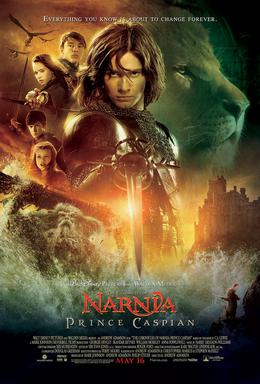
The Chronicles of Narnia: Prince Caspian is a 2008 high fantasy film directed by Andrew Adamson, who co-wrote the screenplay with Christopher Markus and Stephen McFeely, based on the 1951 novel Prince Caspian, Produced by Walt Disney Pictures and Walden Media, the second published and fourth chronological novel in the children's book series The Chronicles of Narnia by C. S. Lewis. The sequel to The Chronicles of Narnia: The Lion, the Witch and the Wardrobe (2005), it is the second installment in The Chronicles of Narnia film series.
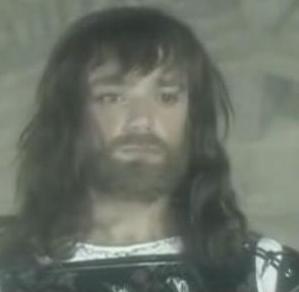
In C. S. Lewis' Chronicles of Narnia fictional series, Rilian (2325-?) is the son of King Caspian and the grandson of Ramandu the star. Rilian appears in two of the seven books, The Silver Chair and briefly in The Last Battle.

The Chronicles of Narnia is a British BBC-produced television serial that was aired from 13 November 1988 to 23 December 1990 and is based on four books of C. S. Lewis's The Chronicles of Narnia series. The first series aired was The Lion, the Witch and the Wardrobe in 1988, the second series aired was Prince Caspian and The Voyage of the Dawn Treader in 1989 and the third series aired was The Silver Chair in 1990. This television serial was produced by Paul Stone, with the teleplay by Alan Seymour. The Lion, the Witch, and the Wardrobe was directed by Marilyn Fox, while Prince Caspian, The Voyage of the Dawn Treader and The Silver Chair were directed by Alex Kirby.
Aslan's Country is a fictional location from C. S. Lewis' The Chronicles of Narnia series. It is the home of Aslan, the great lion. It is described as a series of mountains, tens of thousands of feet high, but without snow or ice. Instead, Aslan's Country has a clear blue sky, lush green grass, colourful birds, and beautiful trees. There are entrances to Aslan's Country from all worlds, including Narnia and Earth. It is located beyond Narnia's rising sun at the eastern edge of the world, and indeed rings around the whole Narnian world.
Lord Drinian is a fictional character in C. S. Lewis's The Chronicles of Narnia. In The Voyage of the Dawn Treader he is the captain of the Dawn Treader and a close friend of King Caspian X. In The Silver Chair, he has remained a trusted advisor of the king, and has also become a close friend of Caspian's son, Prince Rilian.

Aslan is a major character in C. S. Lewis's The Chronicles of Narnia series. Unlike any other character in the Narnian series, Aslan appears in all seven chronicles. Aslan is depicted as a talking lion and is described as the King of Beasts, the son of the Emperor-Over-the-Sea, and the King above all High Kings in Narnia.
The following outline is provided as an overview of and topical guide to Narnia:
Magical creatures are an important aspect of the fictional world of Narnia contained within The Chronicles of Narnia book series and connected media originally created by C. S. Lewis. Throughout the seven books of the series, the protagonists encounter a variety of these creatures as they travel throughout Narnia and the surrounding lands and seas, including Archenland, Calormen, and the Great Eastern Ocean.
















